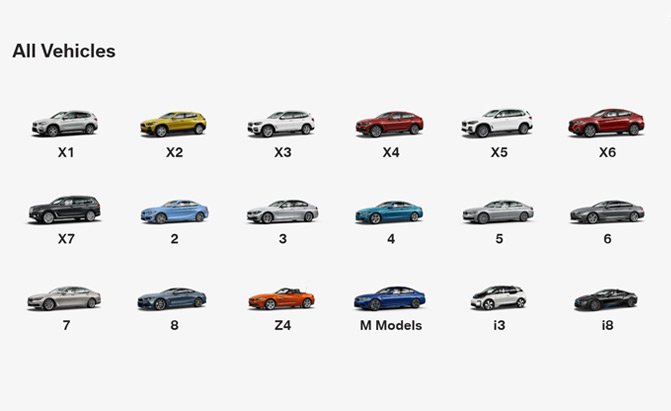BMW Exec Admits the Automaker's Lineup Can Get Confusing

The modern BMW lineup has expanded far beyond its traditional range, which was once limited to the 3, 5 and 7 Series families.
Today, those mainstay sedans are augmented by Sports Activity Vehicles, Gran Turismo models, Sports Activity Coupes, Gran Coupes and more. At first glance, the Bavarian automaker’s showroom seems more than a bit mystifying, but it shouldn’t according to Ralph Mahler, the head of BMW U.S. product planning and strategy. “Actually, the feedback we get is it’s not confusing,” which is good news for the company.
Further explaining things, Mahler noted that smaller numbers represent smaller vehicles, with even figures representing sportier versions of more mainstream products. That seems simple enough from a high-level, but the executive did admit things can get a bit muddy.
Look at a 3 Series sedan and a 4 Series Gran Coupe, for instance. They seem an awful lot alike. But Mahler asked, “How close are the concepts to each other?” adding, “Of course, what we are trying to do is always to differentiate as much as possible and really tailor it to our customer needs.”
SEE ALSO: Volvo XC40 vs. BMW X1 – VIDEO
In this example, Gran Coupe models are designed to be even sportier and more dynamic. “So, they are more driving and handling oriented,” explained Mahler, something customers should notice when they take a test drive.
The BMW lineup is more comprehensive than ever; it seems there’s no market niche the company hasn’t built a vehicle for, but at present are there any holes in their range? Mahler noted that in America there are some huge auto manufacturers that compete in myriad segments, but they must look at things from a global perspective. “We are a small player in the U.S. market overall, but nevertheless, worldwide that’s the important thing,” he said. They won’t compete in every niche; any vehicle they introduce “has to make sense from a worldwide perspective,” meaning there won’t be any BMW full-size, body-on-frame pickup trucks coming to market.
Utility vehicles have greatly increased this German automaker’s product portfolio in recent years. “At the moment we see a real trend towards the crossovers, the SAVs and SUVs,” said Mahler, with sales of cars and utilities running neck and neck. “And also, for us at the moment, we are roundabout 50-50, and the demand is increasing for the crossovers,” so this split could become much more lopsided going forward.
But maybe not forever. “I think once you reach, like, shares of 70 [percent] or something like that… most of the people again will say, ‘I want to be different. I don’t want to be one of this big crowd.’ And then I think it will start to go in a different direction again,” opined Mahler, with traditional cars perhaps regaining ground once more.
There’s a reason crossovers have become so popular. Their elevated seating positions give drivers a better view of the road, they’re incredibly flexible in terms of people and cargo hauling, plus they tend to be very safe. “So, I think overall the concept is really good,” Mahler said, “But I think to differentiate, to show that we are all individuals, I think after a certain threshold if you reach that it will turn again.”
SEE ALSO: 2018 BMW M3 CS Review
Certainly, one reason BMW utility vehicles sell in such great numbers is that they’re generally fun to drive. “When you just look back like, 20 years ago, when we didn’t have any crossovers in our lineup and BMW was The Ultimate Driving Machine, and I think today it still is The Ultimate Driving Machine even though we have these heavy… crossover concepts with a higher center of gravity and stuff like that,” said Mahler. He also noted their utility vehicles are the sportiest and most dynamic in their respective segments.
A key advantage in delivering this performance is that BMW always plans for the M models when starting basic engineering of a vehicle “so the development takes place in parallel,” said Mahler. This allows them to produce a product that in every form or trim level benefits from the company’s ample motorsports experience. Performance-enhancing components or design features can be baked right into a vehicle lineup without having to re-engineer them at a later date, something that can add extra cost, complexity and of course, unwanted mass.
“I think coming up with authentic products is also key for everything to be successful at the end of the day,” noted Mahler. Planning for high-performance models from day one is part of what allows their cars and crossovers to handle and perform better than offerings from rival brands, even if these vehicles’ positions in the BMW lineup is a little unclear.
Discuss this story on our BMW Forum.

Born and raised in metro Detroit, Craig was steeped in mechanics from childhood. He feels as much at home with a wrench or welding gun in his hand as he does behind the wheel or in front of a camera. Putting his Bachelor's Degree in Journalism to good use, he's always pumping out videos, reviews, and features for AutoGuide.com. When the workday is over, he can be found out driving his fully restored 1936 Ford V8 sedan. Craig has covered the automotive industry full time for more than 10 years and is a member of the Automotive Press Association (APA) and Midwest Automotive Media Association (MAMA).
More by Craig Cole



































Comments
Join the conversation
BMW CAR IS THE BEST CAR I HAVE EVER SEEN IN THE WORLD IT HAVE NICE STRUCTURE AND IT FAST